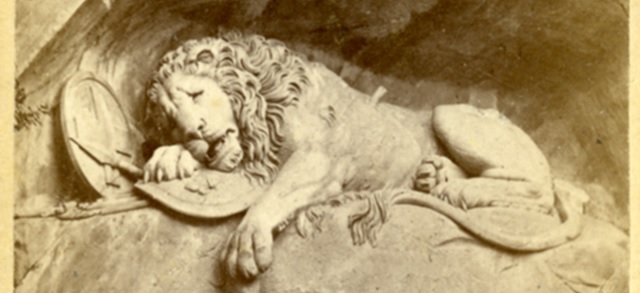
Monuments Class Projects
Architect/Sculptor of Monument
Gian Lorenzo Bernini (1598-1680)
Preview

Medium
photograph, carte-de-viste
Keywords
St. Peter, Vatican, St. Peter's Chair, St. Peter's Basilica, Pope, Papal Throne, Christianity, Papacy, Holy Spirit, Alexander VII, Urban VIII, Gian Lorenzo Bernini, Bernini, Catholic Church, Reliquary, Doctors of the Church
Physical Dimensions
4 x 2.5"
Date of Publication
2025
Date of Publication
1858-1878
Name of Monument
St. Peter's Chair
Date of Completion or Dedication of Monument
1-1666
City of Monument
Vatican City, Rome
Location within City
St. Peter's Basilica
State/Province of Monument
Lazio
Country of Monument
Vatican City
Description
This monument is situated in the apse of St. Peter's Basilica and was designed by Gian Lorenzo Bernini. Representing the origins of the power of the papacy in the Apostle Peter, it serves as a reliquary for what is traditionally considered the saint's chair.
School of Art/Architecture
Baroque
Publisher
D'Alessandri Brothers
Digital Date
2-7-2025
Copyright
Physical copy of the carte-de-visite is in the public domain. Digital copy scanned by Rod Library, University of Northern Iowa.
Creative Commons License

This work is licensed under a Creative Commons Attribution-NonCommercial 4.0 International License
File Format
application/pdf



Comments
St. Peter’s Chair in the Vatican in Rome commemorates the papacy of St. Peter, the first pope of the Roman Catholic Church and ranking apostle of Jesus Christ. His chair in Rome's St. Peter’s Basilica is a focal point for many Catholics.
The monument was designed by Gian Lorenzo Bernini (1598-1680) in 1630. Bernini was an Italian sculptor who, as a young boy, impressed Pope Paul V (1552-1621) and quickly became known in the Vatican circles. When Pope Urban VIII (1568-1644) became pope, he commissioned Bernini to do work for him. During this time, Bernini designed the baldachin, which stands over the high altar and tomb of St. Peter in St. Peter’s Basilica. Bernini next worked on his reliquary for St. Peter’s Chair. In 1656, Pope Alexander VII (1599-1667) moved the chair to the far end of the Basilica where it was unveiled in 1666.
The chair reliquary asserts the papacy’s origins in Christ's Apostle and its supremacy over the Church. The pope believed that displaying the seat of the first pope strengthened the papacy’s legitimacy. The Chair’s position in the apse of St. Peter’s is visible as the focal point at the end of the basilica's central aisle.
Bernini enclosed the original chair in a monumental reliquary. The large monument that Bernini designed to hold the relic is much more elaborate than the chair it enshrines. At its base are four saints supporting the chair. These four, St. Augustine, St. Ambrose, Athanasius, and John Chrysostom, are made wholly of bronze and represent the four Doctors of the Church. “Doctor” used in this context is another word for theologians whose teachings were declared to be trustworthy in theological doctrine. Pope Boniface VIII (1230-1303) declared the four saints supporting the chair to be the original four Doctors, although since then more have been selected.
Above the chair are two “putti”, who are the young babies commonly found in many Renaissance and Baroque works of art. The putti hold keys and the papal tiara, which was used to crown popes until the reign of Paul VI (1963-78). The keys also symbolize the papal authority, one key made of gold which represents the power of God and heaven, while a silver key represents papal authority on earth. These keys are symbolic of the keys Jesus gave to St. Peter in Matthew 16:19 when he said: “I will give you the keys of the kingdom of heaven.” The dove, which in Christianity represents the presence of the Holy Spirit, flies above, in an oval window, which shows bright sunlight. Around the window, golden clouds hold angels who overlook the chair. These show divine protection surrounding the relic as the sun shines through the window and illuminates the gold clouds around the chair.
The relic enclosed inside, an ancient chair, is made out of oak and ivory and plated with gold.The history of the chair dates back to roughly c. 875-877 when the Holy Roman Emperor, Charles the Bald (823-877) gave the throne as a gift to Pope John VIII (reigned 872-882). Today, scholars believe the chair dates from the 6th century, which it put it too late to have any connection with the 1st century St. Peter, despite church tradition that it was his throne.
The reliquary that encloses the chair was created in Italy during the Baroque era. It features a Greek inscription which translates as, “You shepherd the lambs, you tend the sheep of Christ.” This refers to the Gospel of John 21; 15-16 in which Jesus tells Peter to: “Feed my lambs” and “Take care of my sheep”, referring to Jesus’ role as shepherd of his followers, which he was passing on to Peter.
Bernini’s style of sculpture and architecture was Baroque, and is shown in the extreme extravagance and detail in his work. St. Peter’s Chair, with the ornate detail found in its saints, golden clouds, “putti” and the dove in the window all show his grandiose, Baroque style and extravagance.
St. Peter’s Chair is a monument made to show the divine nature of the papacy and specifically to commemorate the first pope, St. Peter, by housing what has traditionally beenconsidered his throne. Its placement in the apse makes it a focal point of the basilica. Its large, impressive scale shows the dominating grasp of Catholic power during the time it was built, as well as the primacy of Peter, whose throne is surrounded by several Doctors of the Church and the angels protecting the office that he originated from any harm.
Bibliography
“Bible Gateway Passage: John 21 - New International Version.” Bible Gateway. Accessed March 12, 2025. https://www.biblegateway.com/passage/?search=John+21&version=NIV.
Boorsch, Suzanne. “The Building of the Vatican: The Papacy and Architecture.” The Metropolitan Museum of Art Bulletin 40, no. 3 (1982): 4-64.
Editor, Online. “Who Are the Doctors of the Church?” U.S. Catholic, April 5, 2021. https://uscatholic.org/articles/201208/who-are-the-doctors-of-the-church/.
McClendon, Charles B. “The History of the Site of St. Peter’s Basilica, Rome.” Perspecta 25 (1989): 33–65.
Milizia, Francesco, and Eliza Taylor tr Cresy. The lives of celebrated architects, ancient and modern: With historical and critical observations on their works, and on the principles of the art. by Francesco Milizia. tr. from the Italian by mrs. Edward Cresy. with notes and additional lives. Vol. 2. London: J. Taylor, 1826.
Moffitt, John F. “BERNINI’S ‘CATHEDRA PETRI’ AND THE ‘CONSTITUTUM CONSTANTINI.’” Notes in the History of Art 26, no. 2 (2007): 23-31.
“Papal Tiara.” Vatican. Accessed March 12, 2025. https://www.vatican.va/news_services/press/documentazione/documents/sp_ss_scv/insigne/triregno_en.html.
S, Christopher. “Vatican Flag.” Vatican flag, April 1, 2020. https://vatican.com/Vatican-flag/.